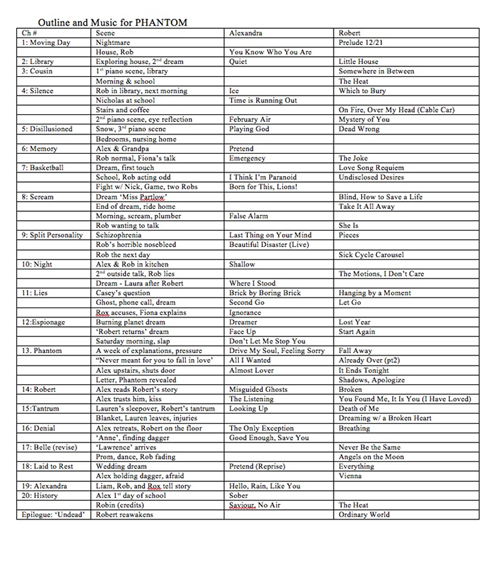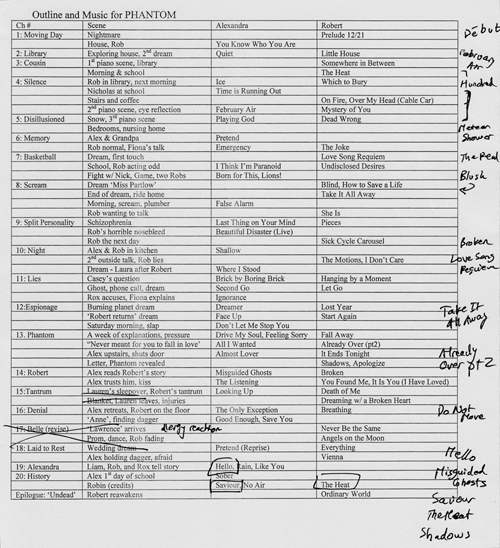Acting with Tables for Arranging Fan Soundtracks
In the previous section, our analysis illuminated the tables and other inscriptions that mediate the textual, visual, and spatial dimensions of Alexandra's fan writing. In this section, we continue our examination of the tables Alexandra acts with to write her novels, focusing on how the tables she uses to generate soundtracks for her novels mediate the aural dimension of her writing. We examine the tables Alexandra uses to create and manage her fan soundtracks in their own section as a way of further unpacking the multiple modes and media simultaneously at play in her literate activity. Examining them in their own sections also further illuminates the multiple tables Alexandra continually coordinates throughout her lifeworlds.
Acting with tables is also central to assembling the soundtracks she creates to accompany and complement key scenes in her novels in anticipation of their being remediated (Bolter & Grusin, 1999) as movies once they are published. In addition to the tables indicating the pairing of song titles with specific scenes in her novels, Alexandra’s iPod includes a playlist of songs for each novel she is working on as well as the ones she plans to write in the future, and she frequently listens to those songs as she does her writing.
In the short video clip (below) from two different interviews, Alexandra briefly mentions the variety of inscriptions that animate her work on Phantom (which we began to discuss in the last section) and then discusses the tables she uses to generate a soundtrack.
As she indicates in the opening portion of the video clip, the columns and rows of the table pulled up on the screen of her laptop, the same one displayed in Figure 11 (right), allow her to “match up” a key scene or scenes from each chapter of her novels with music from the playlist for Phantom on her iPod that amplifies or “multiplies” (Lemke, 1998) what characters are thinking, feeling, or doing. The table indicates each chapter, the key scene or scenes in each chapter, and the two main characters (Alexandra and Robert, the central characters of Phantom) involved in those scenes. By inserting the title of a song in a particular cell, Alexandra can specify a song from her playlist associated with either or both of the characters in each scene. In Chapter 7, for example, for the scene Alexandra describes using the phrase “dream, first touch,” Alexandra specifies for Robert’s character a song titled “Love Song Requiem.” For the next scene in that chapter, which Alexandra indicates as “school, Rob acting odd,” she specifies for Alexandra’s character a song titled “I Think I’m Paranoid” and for Robert’s character a song titled “Undisclosed Desires.”
As Alexandra indicates when she mentions the songs “that are inspiration for the second book and the third book,” a reference to the second and third books she plans to write for her Phantom trilogy, it is frequently the case that the songs serve as the initiating text for key scenes and action for novels she anticipates writing in the future.
As she explains during the latter portion of the video clip, Alexandra frequently revises the pairings of scenes and songs. While she sometimes indicates those changes by writing titles of songs in the margin by the appropriate row, like those shown on the table in Figure 12 (right), more often she indicates those changes by changing the order of the song titles on the screen of her iPod. Later, she will use the re-ordered playlist on her iPod to revise the titles on the chart on her laptop. In a sense, the list of song titles on the screen of her iPod is a representation of the table on her laptop, even though the lines of the table are not apparent.
The tables and inscriptions Alexandra acts with to create soundtracks for her novels allow her to see and hear the world through the eyes and ears of a filmmaker. In this sense, they function as an externalized cochlea as well as an externalized retina, and, further, serve as a way to coordinate the written representations of characters’ actions and feelings (which she anticipates will be re-represented visually on the screen) with the music that highlights them. They also serve many of the same functions as the tables she acts with for her engineering activities. Both the Word version, the digitized version on her laptop and the hard copy version printed out and carried in her notebook, and the playlist on her iPod remind Alexandra which songs she has aligned with each character for each scene. The blank cells of the version on her laptop also remind her of scenes still in need of music. The table and playlist also function as means of re-configuring the pairing of songs to scenes in an efficient manner.


